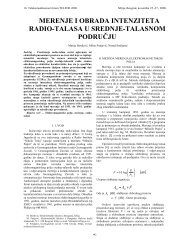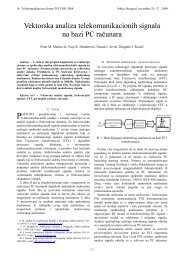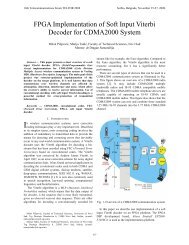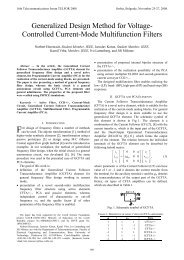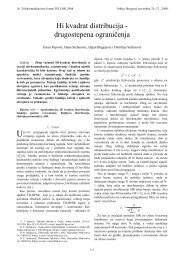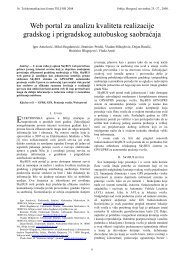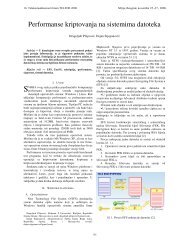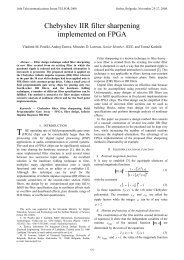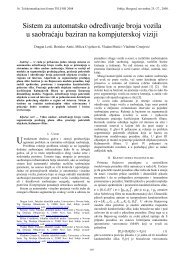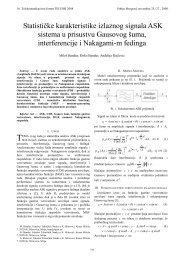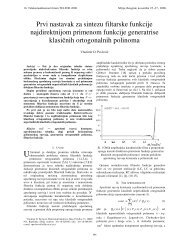Energizing Low Power Circuits by Using an RF Signal ... - Telfor 2008
Energizing Low Power Circuits by Using an RF Signal ... - Telfor 2008
Energizing Low Power Circuits by Using an RF Signal ... - Telfor 2008
Create successful ePaper yourself
Turn your PDF publications into a flip-book with our unique Google optimized e-Paper software.
<strong>Energizing</strong> <strong>Low</strong> <strong>Power</strong> <strong>Circuits</strong> <strong>by</strong> <strong>Using</strong> <strong>an</strong><strong>RF</strong> <strong>Signal</strong> HarvesterMohammad Asefi, AUS, Soudeh Heydari Nasab, AUS, Lutfi Albasha, AUS, <strong>an</strong>d Nasser Qaddoumi, AUSAbstract — In this paper, a method of supplying voltageto a communication system through a wireless system isdiscussed. The main goal of this work is to propose a systemthat exploits <strong>RF</strong> signals (air signals) of 950-960 MHz tocharge a small battery or to run a low power sensor. Thework presented here will mainly focus on the modeling <strong>an</strong>dsimulations aspects of the project.Keywords —Energy harvester, <strong>Low</strong> power circuits, <strong>RF</strong>signal, Sensor powering, wireless powering<strong>an</strong>d vibration, temperature difference <strong>an</strong>d ambient energy[1], [2].The other source for energy harvesters that is beingconsidered is use of <strong>RF</strong> signals. Even though <strong>RF</strong> signalscarry low energy, the power that c<strong>an</strong> be achieved fromthem could be high enough to run a low power sensor ora low power circuit.It worth’s mentioning that the power of air signals c<strong>an</strong>be as high as 30 dBm for GSM frequency which isrelatively high <strong>an</strong>d c<strong>an</strong> be used for low powerapplications.VI. INTRODUCTIONARIOUS methods for wireless tr<strong>an</strong>smission ofinformation have been studied for centuries <strong>an</strong>dm<strong>an</strong>y good results have been achieved. Nowadays,different electronic devices such as Remote TerminalUnits (RTUs), Sensors <strong>an</strong>d Switches communicatewirelessly. In m<strong>an</strong>y applications, these devices arerequired to be independent, me<strong>an</strong>ing that both wirelesstr<strong>an</strong>smission of information <strong>an</strong>d wireless powering arerequired while the system is mobile. Batteries are themain solution for empowering most wireless devices.However, there are some restrictions on the use ofbatteries, one of which is their limited charge. Toovercome this issue, rechargeable batteries c<strong>an</strong> be used,yielding the use of wires <strong>an</strong>d power outlets.At the same time, due to rapid technologicalimprovements, power consumption of different electronicdevices has decreased, which led to the potential ofintroduction of energy harvesters as the power source forlow power consumption devices such as sensors.Basically, harvesters or “scavengers” are small devicesthat convert the free available energy of their surroundinginto electrical power [1]. Depending on their type,harvesters utilize different energies such as solar, motionM. Asefi is with the Department of Electrical Engineering, Americ<strong>an</strong>University of Sharjah, UAE (phone: +971-6-5152948; fax: +971-6-5152979; e-mail: b00021010@aus.edu).S. Heydari Nasab is with the Department of Electrical Engineering,Americ<strong>an</strong> University of Sharjah, UAE (phone: +971-6-5152948; fax:+971-6-5152979; e-mail: g00018396@aus.edu).II. ARCITECTUREHigh frequency signals’ power is limited <strong>by</strong> regulationsto avoid health concerns for hum<strong>an</strong> <strong>an</strong>d battery drainage.Therefore there will not be enough power for triggeringactive element.To achieve a passive circuit that c<strong>an</strong> be adapted toharvest <strong>RF</strong> signals, the circuit of Figure 1 is suggested.Figure 1: System Diagram of <strong>RF</strong> HarvesterSeveral signals of different frequencies are to bedetected <strong>by</strong> this energy harvester, using embedded or amicrostrip <strong>an</strong>tenna. The main reason for using these typesof <strong>an</strong>tennas is their small size, ease of m<strong>an</strong>ufacture <strong>an</strong>dlow cost [3]. The <strong>an</strong>tenna receives different modulatedsignals within its b<strong>an</strong>dwidth.To distinguish these different signals, a simple passivereson<strong>an</strong>t circuit c<strong>an</strong> be used. This type of reson<strong>an</strong>t circuitconsists of a capacitor <strong>an</strong>d <strong>an</strong> inductor. The value of thiscapacitor <strong>an</strong>d inductor is inversely proportional to thesquare of the frequency as shown in equation 1. √1290
Furthermore, one of the main concerns in designing areson<strong>an</strong>t circuit is its quality factor which is defined asthe ratio of its center frequency over its b<strong>an</strong>dwidth(equation 2). (2)conducted. For this purpose, a spectrum <strong>an</strong>alyzer (Rohde& Schwarz FSH3) <strong>an</strong>d a monopole GSM <strong>an</strong>tenna wereused.Figure 3 illustrates the spectrum of <strong>RF</strong> signals existingin frequency r<strong>an</strong>ge of 100 KHz to 3GHz.Therefore, the b<strong>an</strong>dwidth, for a specific centrefrequency, will decrease if the quality factor is increased.This yields a higher frequency selectivity which is ofinterest for the proposed harvester. Also, due toreson<strong>an</strong>ce phenomena, the higher selectivity results in <strong>an</strong>increase in the voltage level of the reson<strong>an</strong>t circuit’soutput. However, there is a need for a voltage boostersince the signals detected <strong>by</strong> the <strong>an</strong>tenna carry lowpower. A Villard voltage multiplier is going to be usedfor this purpose.Voltage multipliers c<strong>an</strong> boost alternating input voltageto a higher level depending on the number of capacitordiodestages used. The most common type of voltagemultiplier is the half-wave series multiplier, which isknown as the Villard cascade [5].In order to add signals of different frequencies, theoutput voltage of the Villard voltage multipliers shouldbe converted into DC voltage which c<strong>an</strong> be done <strong>by</strong> theme<strong>an</strong>s of passive peak detectors.The simplest peak detector circuit that c<strong>an</strong> be usedconsists of a Schottky diode -which has a low built inpotential of approximately 0.2 Volts [6], [7] - <strong>an</strong>d acapacitor.The overall circuit of the harvester is shown in Figure2. In this circuit, capacitors of 1pF, 10pF <strong>an</strong>d 22pF, <strong>an</strong>d<strong>an</strong> inductor of 2.2 nH were used.Figure 3: Spectrum of signals in the r<strong>an</strong>ge from 100 KHz to3 GHzAs it c<strong>an</strong> be seen from the spectrum of Figure 3, thereare different r<strong>an</strong>ges of frequencies in which the power isadequate for the harvester introduced in this paper. Themain challenge in getting power from signals is theircontinuous frequency hopping. However, after studyingthese signals, it was found that the signals withfrequencies within the 950 MHz to 960 MHz r<strong>an</strong>geexperienced less hopping. Moreover, these signals carrymore power. Figure 4 shows one of the states of thesignals in this r<strong>an</strong>ge.Figure 2: The circuit of the <strong>RF</strong> harvesterEven though the harvested signal is boosted <strong>by</strong> themultiplier, the output is not signific<strong>an</strong>t. To attain highervoltage at the output of the harvester several circuits, asthat of Figure 2, c<strong>an</strong> be merged together. In order to addthe output DC signals of the peak detectors, a passiveadder is needed [8].III. FIELD MEASUREMENTSTo inspect the level of available <strong>RF</strong> powers of airsignals, which is variable <strong>an</strong>d dependent on thesurroundings, some environmental measurements wereFigure 4: Spectrum of signals in the r<strong>an</strong>ge from 948 MHz to 960MHz291
It c<strong>an</strong> be seen that the <strong>RF</strong> signals c<strong>an</strong> carry a peakvalue of -15 dBm. Nevertheless, some <strong>RF</strong> signals werefound to have even a peak value of -10.5 dBm.IV. SIMULATIONThe circuit of this harvester was implemented <strong>an</strong>dsimulated in the AWR Analog Office software.First, a single stage circuit (Figure 2) was implemented<strong>an</strong>d its response to a signal of 1GHz with a power of -20dBm was studied <strong>an</strong>d its response is shown in Figure 5.Figure 5: Response of the harvester to <strong>an</strong> input of -20 dBmAlso, the circuit was tested for two other input signals.For the first case, a signal with a power of -15 dBm wasinputted to the system <strong>an</strong>d the output was observed to beapproximately 0.4 V. Then, the output for <strong>an</strong> input signalof -25dBm was observed to be almost 0.06 V. Thedifference in the output for the two cases of -25 dBm <strong>an</strong>d-15 dBm input signals was observed to be large. This wasalso calculated using equation 3 [8].At the current stage of work, the design <strong>an</strong>dimplementation of a prototype is in process. Also, toimprove the perform<strong>an</strong>ce of the system in differentenvironments, the use of a digital signal processor isunder study. The DSP c<strong>an</strong> also be used to overcome theproblem of frequency hopping of signals. However, theDSP requires a power source <strong>an</strong>d the main challenge atthis stage would be powering up the DSP unit.REFERENCES[1] M. Wright, "Harvesters gather energy from the ether,power lightweight systems," EDN, December 2006.[Online].Available:http://www.edn.com/article/CA6399099.html?industryid=2816. [Accessed: 29/3/<strong>2008</strong>].[2] J. P. Thomas, M. A. Qidwai, <strong>an</strong>d J. C. Kellogg,"Energy scavenging for small-scale unm<strong>an</strong>nedsystems," Journal of <strong>Power</strong> Sources, vol. 159, pp.1494-1509, 2006.[3] C.A. Bal<strong>an</strong>is, Antenna theory: <strong>an</strong>alysis <strong>an</strong>d design ,3 rd ed. Hoboken, New Jersey: Wiley & Sons Inc ,2005.[4] P. Scherz, Practical Electronics for Inventors, 2 nd ed.NY: McGraw-Hill, 2006, pp. 194-195.[5] Kind <strong>an</strong>d K. Feser, High-voltage Test Techniques,2 nd ed. UK: Newnes, 2001, pp. 28-30.[6] D. B. Rutledge, The Electronics of Radio, UK:Cambridge Univ. Pr., 1999, p. 38.[7] T. L. Skvarenina, The <strong>Power</strong> Electronics H<strong>an</strong>dbook,FL: CRC Press, 2001.[8] S. Heydari Nasab, <strong>an</strong>d M. Asefi, "<strong>RF</strong> <strong>Signal</strong>Harvester for UAE Spectrum environment," Thirdinternational conference on modeling, simulation<strong>an</strong>d optimization” Sharjah, UAE, to be published(J<strong>an</strong>uary 2009). √ (3)Since the input imped<strong>an</strong>ce Z is const<strong>an</strong>t, as the powerincreases <strong>by</strong> a small amount, the output voltage wouldincrease <strong>by</strong> a considerable amount.V. CONCLUSION <strong>an</strong>d FUTURE WORKIn this paper, <strong>an</strong> <strong>RF</strong> signal harvester for powering lowconsumption electrical devices (such as sensors) wasintroduced. The required environmental studies <strong>an</strong>dsimulation for the purposed system were done <strong>an</strong>d theresults are shown in figures 3, 4 <strong>an</strong>d 5. It was also foundthat some of the signals alter their frequenciescontinuously.292



